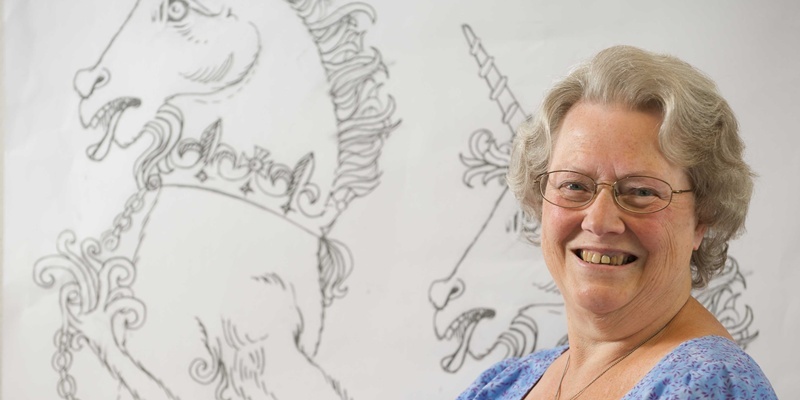Liff woman Eileen Rumble is one of a team of Scotland’s most skilled embroiderers who have completed majestic unicorns and eagles as part of the heraldry to be displayed in Stirling’s royal palace.
The work involved detailed research and expert design followed by months of delicate cutting, shaping and sewing to recreate the heraldry of Mary of Guise, the widowed queen who lived at the palace in the 1540s.
Each element has now been carefully stitched to handmade velvet and brocade backcloths, the largest measuring 3m long, to create cloths of estate which will hang in the Queen’s Inner Hall and Queen’s Bedchamber.
The team was led by textile artist Professor Malcolm Lochhead, of Glasgow Caledonian University, who said, “There’s a great sense of achievement in completing pieces of work of this scale and complexity. We are looking forward to seeing them hung in the palace where they will help create a sense of what it was like to visit a Scottish Renaissance palace in its prime, when it was a busy place where royals and courtiers lived and worked.
“Embroidery of this kind takes a long time, and you get very familiar with each element so much so that we ended up giving pet names to the unicorns and eagles.”
The embroidery has been carried out, where practical, using traditional materials and skills, and the designs were each approved by the Lord Lyon King of Arms, guardian of heraldry in Scotland. The embroiderers working with Malcolm were Mrs Rumble, Liz Boulton of Cumbernauld and Mary McCarron from south Lanarkshire.
Peter Yeoman, Historic Scotland’s head of cultural resources, said, “Malcolm and his team are past masters at producing beautiful cloths of estate. Visitors can see two others at Rothesay Castle and in the Great Hall at Stirling.
“Their latest works are perhaps the most spectacular yet, and I’m sure they will be hugely admired by the hundreds of thousands of visitors who will pass through the palace each year.”
Cloths of estate were of tremendous importance for the nobility in the medieval and Renaissance periods. They acted like personal branding for an individual, and their family, showing their pedigree and social rank something that mattered a great deal in strictly hierarchical societies where so much was determined by birth, title or marriage.
People looking at a cloth of estate would immediately be able to interpret the symbols and judge their own position, and behaviour, in relation to the owner.
Anyone entering the Queen’s Inner Hall and seeing a woman seated beneath a cloth of estate emblazoned with a shield bearing a red Scottish lion rampant and Guise cross of Jerusalem, supported by a unicorn and eagle, all topped by a crown, would know to bow very deeply indeed.
Historic Scotland is close to completing a £12 million project, the centrepiece of which is the refurbishment of six royal apartments, returning them to how they may have looked in the mid-16th century.
